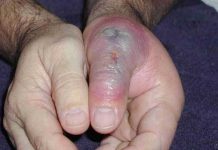How do our bodies efficiently distribute our weight? The answer is in the arches of our feet. When those arches are lowered or nonexistent, it changes the way our legs carry the weight.
This puts extra stress on bones, ligaments, and muscles.
Flat feet, or fallen arches, is a condition that affects up to 30 percent of the population.
But it’s not a serious issue for most. A significant portion of people with flat feet don’t experience any symptoms beyond getting fatigued more quickly from standing or walking.
However, with the warmer beach sandals and flip-flop season upon us, this question looms: Can these shoes actually cause your arches to fall? If you do have flat feet, should you leave summer heels in the closet?
Flat feet are mostly genetic, but you can have fallen arches if….
A majority of flat feet cases are genetic. Some people are just born with lowered or nonexistent arches. So if you don’t already have flat feet, it’s unlikely that you’ll develop them, no matter what you wear on your feet.
However, severe trauma to the feet — from a bad sports injury or car accident, for example — can cause arches to fall, as can systemic conditions like diabetes.
Interestingly, Dr. Mitchell Shikoff, DPM, FACFAS, vice president of the American Board of Podiatric Medicine, tells us that pregnancy, and the hormones that follow, is a common cause.
“These hormones [which allow the pelvis to widen during childbirth] also cause ligaments in other parts of the body to relax, including the feet, leading to fallen arches. This condition typically does not reverse after pregnancy,” he says.
Follow these 5 tips for happy, healthy flat feet
1. Avoid flats
Those totally flat, thong-style sandals might look great on the boardwalk this summer, but they aren’t the best for your feet.
“Almost everyone will want some type of arch support from their footwear,” says Dr. Shikoff. “But if the arch is too pronounced, it can actually cause pain for people with flat feet.”
2. Make sure your shoes have an arch
Ideally, you want a shoe that supports the natural shape of your arch — not too flat, not too high.
You may need to experiment with a few different shoe brands to find one that provides support without digging painfully into your foot.
3. Try inserts, if you don’t want to buy new shoes
If you’re comfortable with your shoe choice but are still experiencing pain, the next step in treatment is to look at inserts. Do some research on the big brands like Dr. Scholl’s and PowerStep to see which models might be best for you.
Pro-tip: Go custom. Custom orthotic inserts will cost a little more than the ones at your neighborhood drugstore, but since they are created from a mold of your foot, they should strike the perfect balance between comfort and support. Check with your local orthopedist or foot and ankle specialist to find out more.
4. Get shoes that are designed for what you’re doing
For the active types, Dr. Shikoff says to make sure you select shoes made for the activities you partake in the most. If you’re a runner, get a good pair of running shoes; if you play tennis, choose comfortable tennis shoes.
If you’re just starting out exercising and aren’t sure what you’ll take to, invest in a pair of cross-trainers. These versatile shoes support your feet for both sports with lateral movement (think football and basketball) and normal running and walking.
5. Love your current shoes? Limit your time standing or walking
What if you’ve already got your heart set on a pair of sandals for a big barbecue or picnic? You’ll probably be fine, even if you have flat feet.
A night out here and there in unsupportive shoes won’t cause permanent harm — but chronic foot pain can happen when you start to walk around in them all day, every day.
Try to limit the amount of time you spend walking or standing, and rest your feet whenever you get a chance.


























